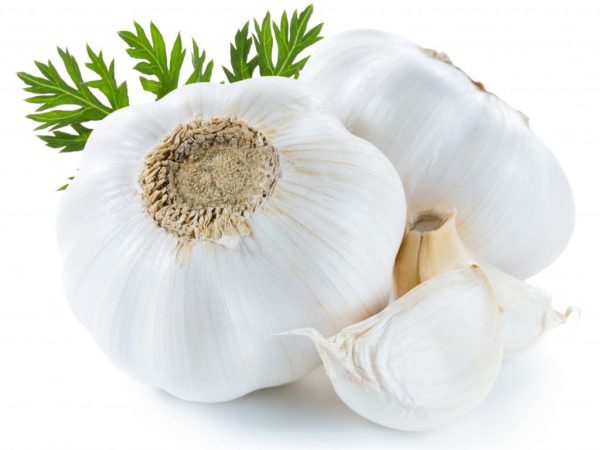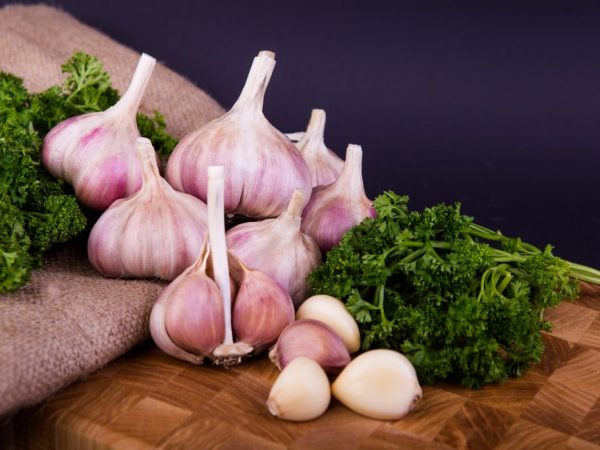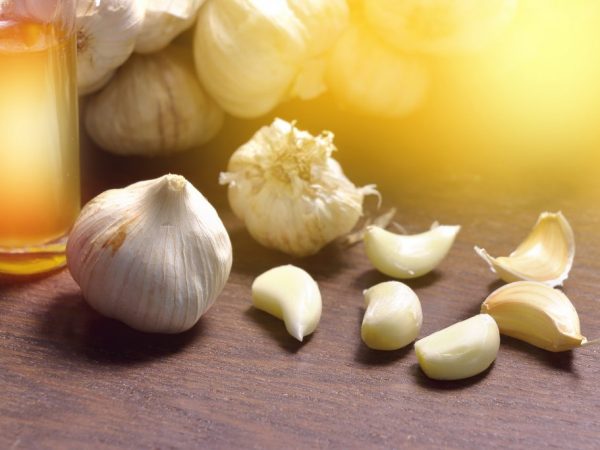What vitamins are included in garlic
Most vegetable growers love to grow garlic. He is undemanding to the external environment. Easy to care for and does not need frequent feeding, watering. But the main advantage is the vitamins contained in garlic. It is they who give value to the vegetable culture.

Vitamins in garlic
Each clove of garlic is a storehouse of vitamins and minerals. They are used for infectious diseases, flu. This is an excellent preventive measure.
Chemical composition and trace elements
The benefit of garlic is not only in its taste and smell. The trace elements contained in the vegetable make it a valuable nutritious product. They support the vital functions of the body. According to recent studies, there are about 17 important trace elements in this vegetable crop:
- Germanium - activates oxygen, strengthens the walls of blood vessels. Prevents varicose veins, makes blood vessels more elastic. A large amount is found in the cloves and leaves.
- Selenium - removes toxins from the liver, improves the processes of regeneration of the scalp, hair, nails in the body. Prevents intoxication in case of poisoning with salts of heavy metals.
- Iodine - improves the functioning of the thyroid gland. Improves metabolism. Controls the vitamin, fat, protein, water supply of the body.
- Sulfur - contributes to the destruction of harmful and dangerous bacteria (staphylococci, dysentery and typhoid sticks, pathogenic fungi and yeast). Sallyl cysteine sulfide and diallyl - sulfur-containing substances - are capable of destroying cancer cells at the initial stage of the disease.
- Phytoncides - quickly eliminate any viral elements.
- Allicin and adonisitis - thin the blood and prevent blood clots.
- Pentosan - has a fibrinolytic effect, that is, it dissolves intravascular blood clots.
- Glucosides - increase the sensitivity of tissues to insulin. They activate metabolic processes.
- Pectin - improves digestion. Makes urination painless.
- Essential oils - neutralize toxic substances. They remove toxins from the body, improve the work of the gastrointestinal tract.
- Phosphorus - maintains the normal condition of teeth and bones, strengthens them. Promotes mental and muscle performance.
- Potassium - is responsible for the good functioning of the muscles of the heart and adjusts the normal rhythm of the organ. Regulates water balance.
- Copper - saturates the blood with oxygen. Great for improving the strength of teeth and bones. Reduces exposure to harmful microorganisms.
- Zirconium - stimulates rapid healing of wounds. Relieves allergic symptoms. Prevents pus from developing and spreading infection.
Garlic is rich in organic acids. They support the functioning of the entire body.
Molybdenum helps in the metabolism of carbohydrates and fats, which helps to eliminate excessive amounts of them. Manganese improves the functioning of nerve cells, activates the work of the main brain. Takes an active part in metabolic vitamin processes.
Cobalt - prolongs youth, slows down the aging process.Thanks to him, gray hair appears later. The largest amount of useful microelements is found in the cloves - from 1.5% to 3.5%, and leaves - up to 9%.
You need to consume one clove a day. It is a great stimulant of the immune system.
There is no definition of which vitamin in garlic is more important for the body. They are beneficial only when taken together.
Vitamins
The vitamin composition of garlic is no less rich. The chemical composition of this vegetable can vary depending on the season, but the main one does not.
In spring, fructose and glucose predominate in the leaves and young teeth. In autumn, the content of vitamins and microelements in garlic is replenished with sucrase and insulin.

The amount of vitamins depends on the expression conditions
It is impossible to say for sure which vitamins prevail in garlic when the vegetable reaches its maximum maturity, it all depends on the growing conditions of the crop, the frequency of watering and soil composition. But, each component present in the plant plays an important role and significantly affects the human body.
To find out how many vitamin substances garlic contains, the table will help:
- Vitamin B1 - 0.2 mg;
- Vitamin B2 - 0.1 mg;
- Vitamin B3 - 0.7 mg;
- Vitamin B6 - 1.2 mg;
- Vitamin B9 - 3 mg;
- Vitamin E - 0.8 mg
This proves that the content of useful vitamins in garlic is sufficient for the full functioning of the body. Minerals help not only restore it after an illness, but are also useful for preventive purposes.
These calculations show how many vitamins are in garlic in 100 grams. The average weight of one head of an onion plant is 25-30 grams.
Vitamin B1
There is another name - thiamine. It improves mood. Optimizes brain activity. Improves mental performance.
Vitamin B1 normalizes appetite. It has a positive effect on height and weight. Improves blood circulation.
Vitamin B2
Its content in the total mass is small. But it affects the condition and appearance of human skin. Makes it elastic, smooth, even, healthy.
Riboflavin heals wounds on the skin or mucous membranes. Helps burn sugar and unhealthy fats.
Vitamin B3
Vitamins B3 contained in garlic are involved in respiratory and redox processes. Break down food into proteins, fats, carbohydrates. Lower blood cholesterol levels.
They expand small vessels. They have an anticoagulant effect. Reduces joint and back pain. Useful for emotional and mental breakdowns.
Vitamin B6
Improves the contractility of the muscles of the heart. Responsible for the normalization of the assimilation of everything: proteins, fats, carbohydrates, useful microelements. Essential for good liver function.
Slows down the aging process and the appearance of wrinkles. Reduces the number of spasms and seizures. It has a diuretic effect. Promotes rapid recovery from skin diseases.
Vitamin B9
Folic acid is actively involved in hematopoiesis. It has a positive effect on the functioning of the intestines and stomach. Normalizes liver function.
Prevents the development of infectious and influenza diseases. Improves the immune system. During pregnancy, it forms normal nerve cells in the embryo.
Vitamin C
Another name for the vitamin is ascorbic acid. Takes an active part in metabolic processes. Regulates blood clotting. Significantly reduces the permeability of the vascular walls.

A small amount of garlic fills the body with vitamins
Neutralizes the effects of allergens. Has anti-inflammatory effect. Removes harmful substances from the body.
Vitamin E
In women, it eliminates painful sensations during menstruation. Other beneficial properties:
- positively affects the functioning of the pancreas and mammary glands;
- accelerates the process of removing toxins and toxins from the body;
- allows you to maintain normal skin.
Improves blood circulation in the scalp. Normalizes the condition of the whole organism.
Vitamin D
Facilitates the course of allergic reactions in adults and children. It prevents the growth of cancer cells, reduces their effect on the general condition of a person. It has a positive effect on muscle and adipose tissue.
Reduces the risks of age-related diseases, especially in the elderly. Normalizes kidney function.
Vitamin PP
Improves the general condition of blood vessels. Reduces blood cholesterol levels. Nicotinic acid normalizes the entire cardiovascular system. Makes internal organs less susceptible to pests.
Promotes tissue growth and cell regeneration. Responsible for the normal functioning of all organs of the gastrointestinal tract. Stimulates the liver.
Contraindications
Despite the vitamins contained in table garlic, it can be dangerous to humans. You need to know how many cloves you can eat in one day.
According to medical research, it is recommended to consume no more than 3 cloves in 2-3 days. They contain a sufficient amount of vitamins. Remember, whoever eats garlic is less sick and more resistant to bacteria and infections.
Harm from garlic
With excessive use of the bulbs and cloves of this vegetable crop, a person is in danger of death. And it doesn't matter what useful vitamins garlic contains. There will be no benefit from them.
Stop eating garlic cloves if:
- burning sensation;
- heartburn;
- pain in the pancreas;
- problems in the gastrointestinal tract;
- colic, etc.
Onion crops can make the situation worse. This is due to the presence of a sulfonyl hydroxyl ion in it. It penetrates the brain and causes discomfort.
Excessive use can cause meteoism, dairea, acute glomerulonephritis. People with hemorrhoids and overweight need to reduce the daily intake of the product. The plant increases appetite and contributes to constipation.
Dangerous foods include garlic for those with epileptic seizures. By activating the nervous system, it can cause another attack.
The period of pregnancy and lactation is a forbidden time for eating garlic. It is not recommended to eat more than 1 clove every 2 days. Otherwise, the taste of the milk may deteriorate.
When treating, add garlic to your daily diet only with the permission of your doctor. It contains up to 10% harmful substances. They can cause intoxication of the body and complication of the disease.
Conclusion
Garlic is a healthy food that should be included in the diet. The composition contains useful trace elements and minerals. Knowing what vitamin is contained in garlic, you can speed up the process of treating a certain disease. It is used as a preventive measure.
100 g of onion product contains up to 17 chemical elements and about 12 vitamins of different groups (B, C, D, PP, E). It is important to consume no more than the standard value - up to 3 cloves in 2 days. Otherwise, the healing process may be delayed. The general condition of the body will worsen, and the disease will become more complicated. Therefore, you need to carefully monitor the amount of garlic eaten and consult your doctor!

